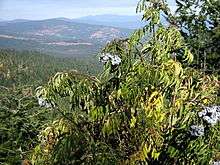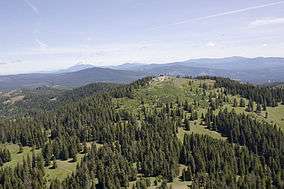Cascade–Siskiyou National Monument
| Cascade–Siskiyou National Monument | |
|---|---|
|
Soda Mountain | |
 | |
| Location | Jackson County, Oregon, United States |
| Nearest city | Medford |
| Coordinates | 42°04′40″N 122°27′40″W / 42.07778°N 122.46111°WCoordinates: 42°04′40″N 122°27′40″W / 42.07778°N 122.46111°W |
| Area | 86,774 acres (35,116 ha)[1] |
| Established | June 9, 2000[2] |
| Governing body | Bureau of Land Management |
| Website | Cascade–Siskiyou National Monument |
The Cascade–Siskiyou National Monument is a national monument that protects 86,774 acres (35,116 ha)[1] of forest and grasslands at the junction of the Cascade Range and the Siskiyou Mountains in southwestern Oregon, United States. The monument is managed by the Bureau of Land Management as part of the National Landscape Conservation System and was established in a presidential proclamation by President Bill Clinton on June 9, 2000.
History
Native Americans are known from archaeological excavations to have inhabited the region for thousands of years. Nearly 100 dwelling and root-gathering sites belonging to the Modoc, Klamath, and Shasta tribes have been uncovered to date. By the 1880s, they had been completely replaced by white settlers, whose mining cabins still dot the region.[3][4]
Natural features in the monument include Pilot Rock, a volcanic neck or interior of an extinct volcano, similarly formed as Devils Tower in Wyoming, and the Soda Mountain Wilderness.
The Pacific Crest Trail runs through the monument area. There is a fire lookout tower on the top of Soda Mountain built in 1962 to replace the original 1933 structure. Although the top of the mountain is also the site of dozens of television and radio broadcast and relay dishes, the view from the fire lookout of the surrounding mountains is unobstructed. From the lookout, one can see Mount Shasta, Mount Ashland, Mount McLoughlin, and on clear days, the rim of Crater Lake.[5]
The Cascade–Siskiyou National Monument land use plan has been the source of local and national controversy over multi-use planning for wilderness and roadless areas.[6] The plan currently strives for a balance between managing rare natural habitat, recreational activities, and agricultural activities including cattle grazing and timber.
Numerous private land inholdings remain within the boundaries of the Monument. The Southern Oregon Land Conservancy holds a conservation easement on a 1,312 acre private property near Siskiyou Summit.
In May 2015, 70 scientists endorsed the April 2011 Cascade-Siskiyou Scientific Report and the need for Monument expansion bringing the total number of scientists speaking out on expansion to 85.[7] Additionally, science-based expansion of the Cascade–Siskiyou National Monument is formally endorsed in writing by:
- The Ashland Chamber of Commerce board (June 2015)
- The Talent Chamber of Commerce board (July/August 2016)
- The Ashland City Council (June 2015)
- The Talent City Council (August 2016)
- The Mayor of Ashland (March /July 2016)
- The Mayor of Talent (August 2016)
- Local Oregon state Representative Peter Buckley (July 2015)
- Local Oregon state Senator Alan Bates (August 2015; deceased August 2016)
- Private landowners accounting for over 14,000 acres within the general scientists' recommended monument expansion area (2015 and 2016)[8]
The monument adoption and expansion are opposed by the Jackson and Klamath County, Oregon Boards of Commissioners, the Siskiyou County Supervisors and a group local people calling themselves the "No Monument Tribe".[9]
Flora and fauna

The Cascade–Siskiyou National Monument is the first U.S. National monument set aside solely for the preservation of biodiversity.[2] It has one of the most diverse ecosystems found in the Cascade Range. 200 species of birds are known to exist in the monument including some threatened and endangered species such as the great grey owl and peregrine falcon.[3] Amphibians found in the National Monument include the rough-skinned newt.
Cascade–Siskiyou National Monument is noted for its significant botanical diversity. The range of elevations and diversity of habitat types provides for a spectacular flora that includes many endemics to the immediate Siskiyou crest area, such as Green's mariposa lily (Calochortus greenei). The federally endangered Gentner's fritillary (Fritillaria gentneri) is known to occur in the monument.
See also
References
- 1 2 "National Monument detail table as of April 2012" (PDF). Bureau of Land Management. Retrieved 2012-12-27.
- 1 2 Minor, Kathy. "Cascade Siskiyou National Monument". Bureau of Land Management. Retrieved 2009-03-26.
- 1 2 Cascade–Siskiyou National Monument - The Conservation System Alliance
- ↑ Cascade–Siskiyou National Monument - Earthjustice: Environmental Law
- ↑ Sullivan, William L. (1999). 100 Hikes in Southern Oregon. Eugene, Oregon: Navillus Press.
- ↑ Fattig, Paul (March 2000). "Commission: Keep Soda Mountain open". Mail Tribune. Archived from the original on March 9, 2001.
- ↑ http://media.wix.com/ugd/93b739_8b109b376d0748fe96fbc8faa2e7aa9a.pdf
- ↑ http://www.expandcascadesiskiyou.org
- ↑ http://nomonument.com
External links
 Media related to Cascade-Siskiyou National Monument at Wikimedia Commons
Media related to Cascade-Siskiyou National Monument at Wikimedia Commons- Bureau of Land Management.gov: official Cascade-Siskiyou National Monument website
- Conservation System Alliance: Cascade–Siskiyou National Monument — (archived)
- Ucsb.edu—American Presidency Project: Presidential proclamation establishing the Cascade–Siskiyou National Monument
- Oregon Wild.org: Soda Mountain Wilderness Campaign -
- National Monument Expansion Project
- Wilderness.org: Cascade-Siskiyou National Monument
- NCCSP land management projects: Cascade-Siskiyou National Monument
- Pacificwestcom.com: Jenny Creek Private Lands Coalition — private property rights advocates.
- The No Monument Tribe.
